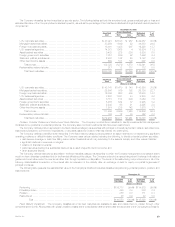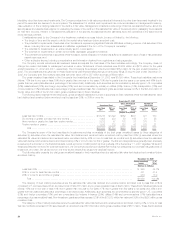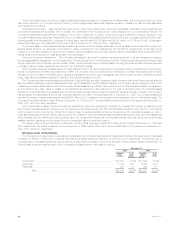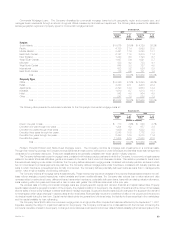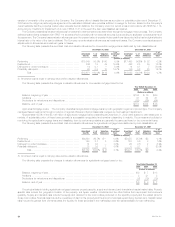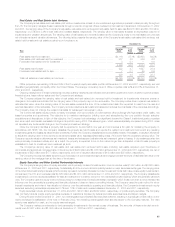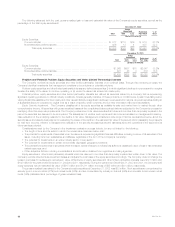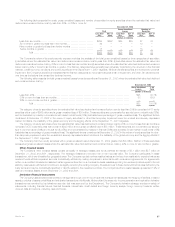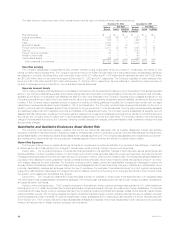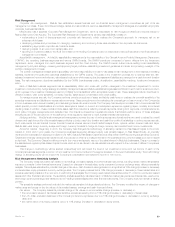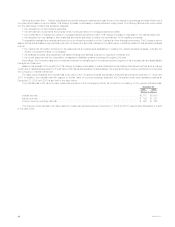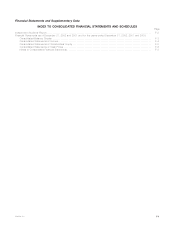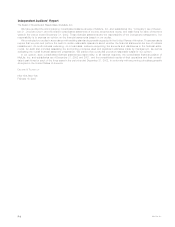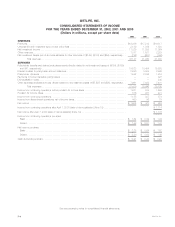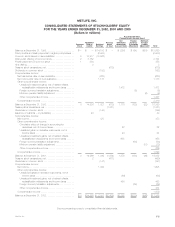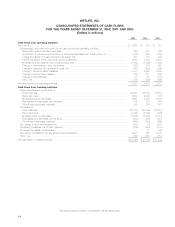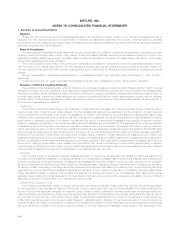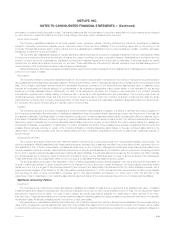MetLife 2002 Annual Report Download - page 43
Download and view the complete annual report
Please find page 43 of the 2002 MetLife annual report below. You can navigate through the pages in the report by either clicking on the pages listed below, or by using the keyword search tool below to find specific information within the annual report.Risk Management
Corporate risk management. MetLife has established several financial and non-financial senior management committees as part of its risk
management process. These committees manage capital and risk positions, approve asset/liability management strategies and establish appropriate
corporate business standards.
MetLife also has a separate Corporate Risk Management Department, which is responsible for risk throughout MetLife and reports directly to
Metropolitan Life’s Chief Actuary. The Corporate Risk Management Department’s primary responsibilities consist of:
)implementing a board of directors-approved corporate risk framework, which outlines the Company’s approach for managing risk on an
enterprise-wide basis;
)developing policies and procedures for managing, measuring and monitoring those risks identified in the corporate risk framework;
)establishing appropriate corporate risk tolerance levels;
)deploying capital on an economic capital basis; and
)reporting on a periodic basis to the Audit Committee of the Holding Company’s board of directors and various financial and non-financial senior
management committees.
Asset/liability management. At MetLife, asset/liability management is the responsibility of the General Account Portfolio Management Department
(‘‘GAPM’’), the operating business segments and various GAPM boards. The GAPM boards are comprised of senior officers from the investment
department, senior managers from each business segment and the Chief Actuary. The GAPM boards’ duties include setting broad asset/liability
management policy and strategy, reviewing and approving target portfolios, establishing investment guidelines and limits, and providing oversight of the
portfolio management process.
The portfolio managers and asset sector specialists, who have responsibility on a day-to-day basis for risk management of their respective investing
activities, implement the goals and objectives established by the GAPM boards. The goals of the investment process are to optimize after-tax, risk-
adjusted investment income and after-tax, risk-adjusted total return while ensuring that the assets and liabilities are managed on a cash flow and duration
basis. The risk management objectives established by the GAPM boards stress quality, diversification, asset/liability matching, liquidity and investment
return.
Each of MetLife’s business segments has an asset/liability officer who works with portfolio managers in the investment department to monitor
investment, product pricing, hedge strategy and liability management issues. MetLife establishes target asset portfolios for each major insurance product,
which represent the investment strategies used to profitably fund its liabilities within acceptable levels of risk. These strategies include objectives for
effective duration, yield curve sensitivity, convexity, liquidity, asset sector concentration and credit quality.
To manage interest rate risk, the Company performs periodic projections of asset and liability cash flows to evaluate the potential sensitivity of its
securities investments and liabilities to interest rate movements. These projections involve evaluating the potential gain or loss on most of the Company’s
in-force business under various increasing and decreasing interest rate environments. The Company has developed models of its in-force business that
reflect specific product characteristics and include assumptions based on current and anticipated experience regarding lapse, mortality and interest
crediting rates. In addition, these models include asset cash flow projections reflecting interest payments, sinking fund payments, principal payments,
bond calls, mortgage prepayments and defaults. New York Insurance Department regulations require that MetLife perform some of these analyses
annually as part of the annual proof of the sufficiency of its regulatory reserves to meet adverse interest rate scenarios.
Hedging activities. MetLife’s risk management strategies incorporate the use of various interest rate derivatives that are used to adjust the overall
duration and cash flow profile of its invested asset portfolios to better match the duration and cash flow profile of its liabilities to reduce interest rate risk.
Such instruments include financial futures, financial forwards, interest rate and credit default swaps, floors, options, written covered calls and caps.
MetLife also uses foreign currency swaps and foreign currency forwards to hedge its foreign currency denominated fixed income investments.
Economic Capital. Beginning in 2003, the Company has changed its methodology of allocating capital from Risk Based Capital to Economic
Capital. In 2002 and in prior years, the Company’s business segments’ allocated equity was primarily based on Risk Based Equity, an internally
developed formula based on applying a multiple to the NAIC Statutory Risk Based Capital and includes certain GAAP accounting adjustments. Economic
Capital is an internally developed risk capital model, the purpose of which is to measure the risk in the business and to provide a basis upon which capital
is deployed. The Economic Capital model accounts for the unique and specific nature of the risks inherent in MetLife’s businesses. This is in contrast to
the standardized regulatory Risk Based Capital formula which is not as refined in its risk calculations with respect to the nuances of different companies’
businesses.
This change in methodology will be applied prospectively and will impact the level of net investment income and net income of each of the
Company’s business segments. A portion of net investment income is credited to the segments based on the level of allocated equity. This methodology
change of allocating equity will not impact the Company’s consolidated net investment income or net income.
Risk Measurement; Sensitivity Analysis
The Company measures market risk related to its holdings of invested assets and other financial instruments, including certain market risk sensitive
insurance contracts (‘‘other financial instruments’’), based on changes in interest rates, equity prices and currency exchange rates, utilizing a sensitivity
analysis. This analysis estimates the potential changes in fair value, cash flows and earnings based on a hypothetical 10% change (increase or decrease)
in interest rates, equity prices and currency exchange rates. The Company believes that a 10% change (increase or decrease) in these market rates and
prices is reasonably possible in the near-term. In performing this analysis, the Company used market rates at December 31, 2002 to re-price its invested
assets and other financial instruments. The sensitivity analysis separately calculated each of MetLife’s market risk exposures (interest rate, equity price
and foreign currency exchange rate) related to its non-trading invested assets and other financial instruments. The Company does not maintain a trading
portfolio.
The sensitivity analysis performed included the market risk sensitive holdings described above. The Company modeled the impact of changes in
market rates and prices on the fair values of its invested assets, earnings and cash flows as follows:
Fair values. The Company bases its potential change in fair values on an immediate change (increase or decrease) in:
)the net present values of its interest rate sensitive exposures resulting from a 10% change (increase or decrease) in interest rates;
)the U.S. dollar equivalent balances of the Company’s currency exposures due to a 10% change (increase or decrease) in currency exchange
rates; and
)the market value of its equity positions due to a 10% change (increase or decrease) in equity prices.
MetLife, Inc. 39


